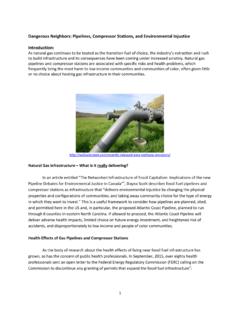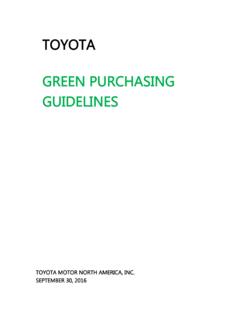Transcription of Controlling Invasive Plants - North Carolina Botanical Garden
1 Controlling Invasive Plants North Carolina Botanical Garden . THE UNIVERSITY OF North Carolina AT CHAPEL HILL. Introduction The goal of this booklet, now in its second edition, is to educate residents of the North Carolina Piedmont about the common Invasive plant species of their gardens and yards, and those found in surrounding natural areas. A further goal is to The spread of Invasive alien species is creating complex and provide information on how to control Invasive Plants in the far-reaching challenges that threaten both the natural and landscape. You will find here information on the identification biological riches of the earth and the well being of it citizens.. and control of these Plants , as well as information resources for Yvonne Baskin other Invasive species not included in these plant profiles.
2 The best way to avoid Invasive plant problems is prevention. We must make no mistake .. we are seeing one of the great Simply put do not purposefully introduce Plants known to be historical convulsions of the world's fauna and flora. Invasive into your Garden or yard. The second easiest method for Controlling Invasive Plants is early detection followed by Charles Elton a rapid response. One Invasive plant is much easier to control than thousands! By having a copy of this booklet, you are on the right path: knowing what Plants to look for as invaders early on is extremely important. Controlling established Invasive Plants can be a challenge. Be persistent in your efforts: control of invasives often requires repeated effort, possibly over several seasons.
3 The rewards, however, greatly outweigh the effort. Controlling Invasive Plants in your Garden and yard will beautify your surroundings, increase the diversity of native Plants and animals, and promote healthy ecosystems in which humans are On the Cover, clockwise from top right: deeply intertwined. Chinese wisteria (Wisteria sinensis), Japanese stiltgrass (Microstegium vimineum), and Finally, we hope that you will share this information. It is Oriental bittersweet (Celastrus orbiculatus). important that we work together to control Invasive species This Page: Drawing of Porcelainberry and minimize their impact in our natural and landscaped (Ampelopsis brevipedunculata) by Sandra communities. Brooks-Mather. 8 2007 North Carolina Botanical Garden Controlling Invasive Plants 1.
4 What is an Invasive plant? Treatment of Invasive Plants An Invasive plant is a species found outside its native range The table below serves as a guide to Controlling most Invasive that threatens the survival or reproduction of native Plants Plants , including species not listed in the Invasive plant profiles or animals, or that threatens to reduce biological diversity. on the following pages. Most of our Invasive Plants have origins in Asia due to that continent's similarity in geographical and environmental conditions to the southeastern United States. These species Habit Duration Spring Summer Fall Winter arrive here as both accidental and intentional introductions. P CP, GD, CP, GD, Deciduous P. seedlings HS, P HS, P. Tree P CP, GD, CP, GD, CP, GD, Why control Invasive species?
5 Evergreen seedlings HS, P HS, P HS, P. Invasive species can cause significant damage to ecosystems, communities, habitats, and native species. They also pose Deciduous P CP, P, S CP, P, S P. problems for people. There are large economic costs associated Shrub with the control of Invasive species (millions of dollars annually). Once established, Invasive plant species decrease the Evergreen P CP, P, S CP, P, S CP, P, S. diversity of native Plants and decrease the visual and inherent value of our natural areas. Annual C, P, S C, P, S C, P, S N/A. Controlling Invasive species in your yard can help reduce Herb the cost of control to your community and can encourage the Perennial C, P C, P, S C, P, S CM, P. growth of native species. The native species you promote can help to increase pollinators and the diversity of animals that you will see in your yard.
6 Native Plants and animals not only C, CP, Deciduous C, CP, P C, CP, P, S P. provide a greater variety of beauty; they also provide valuable P, S. Vine services, including naturally cleaning our water and air and C, CP, C, CM, helping to protect us from floods. By Controlling Invasive Evergreen C, CP, P C, CP, P, S. P, S P, S. species you can help conserve a better world for all of us and celebrate our region's natural history. C = Cut, CM = Cardboard & mulch, CP = Cut & paint, GD = Girdle HS = Hack & squirt, P = Pull, S = Spray Please refer to the next two pages Guidelines for Treatment of Invasive Plants for descriptions of the control methods listed in the above table. 2 Controlling Invasive Plants Controlling Invasive Plants 3. Guidelines for Treatment of Girdle (GD): For larger trees and shrubs, remove the bark and Invasive Plants vascular tissue immediately underneath the bark.
7 Using an axe, hatchet, saw, or chainsaw, cut a ring all the way around the Cut (C): For some Plants , continual cutting can exhaust the trunk of the plant near the base. Immediately applying a energy stored in roots. Do not, however, mow or string-trim 15 25% solution of glyphosate herbicide* to the wound Plants that have gone to seed, as this will spread the seeds. increases effectiveness. Hand cut Plants with seeds and fruits, place them in a bag and put in the trash, not in your yard waste. Cutting can stimulate Hack and Squirt (HS): Using an axe or hatchet, make several re-sprouting, so repeat the cutting or treat the re-sprouts with uniform cuts on the trunk of a tree or shrub. The cuts should be foliar spray to increase the effectiveness of management.
8 Closely spaced and angle downward to create a cup. Spray a 15 25% solution of glyphosate herbicide* immediately into the Cardboard and Mulch (CM): This method is an effective wounds to fill the cups.. treatment on dense ground covers. Cut back all vegetation as far as possible and remove vines from trees. Completely cover Pull (P): Pull or grub the Plants , being sure to remove the entire the area with cardboard, overlapping edges and securing if plant including the roots. Leaving roots can allow the plant to necessary. Cover cardboard with organic mulch, wet, and re-sprout. This method is most effective on herbaceous Plants create drainage holes where water pools. The cardboard may and seedlings. For larger trees and shrubs, specialized tools be left to compost in place.
9 Pull any sprouts that appear. This may be necessary. treatment will supress all vegetation under the cardboard. Spray (S): Using a 1 2%. or ready-to-use solution of Warning! Cut and Paint (CP): For *What is glyphosate? trees, shrubs, and vines glyphosate herbicide,* thor- Herbicides can be hazardous to humans and to the environment: Glyphosate is a general-use pesti- that are too large to pull, oughly wet the foliage of the use all herbicides with caution. cide sold under a variety of trade make a level cut through Invasive Plants (foliar spray). When using herbicides, be sure to names, including Roundup . It will kill Species with waxy leaves most Plants . Glyphosate is available the stump close to the read the label, follow all recom- ground and clear away may require a 5% solution mended instructions, and use per- at most Garden centers in Ready to Use solutions, concentrate, or super- debris.
10 Immediately of glyphosate. Care must sonal protection equipment. When be taken to avoid spraying using herbicides around water, be concentrate forms. Dilute all concen- paint or spray the outer sure to use the appropriate prod- trate glyphosate with water to create two-thirds of the stump nearby desirable Plants . Do ucts, as some herbicide mixtures different percent solutions acceptable with a 15 25% solution not spray on windy days. are toxic to fish and freshwater for use. Most sprayers create a fine of glyphosate herbicide.* organisms. What is a percent solution? This treatment is most mist that coats the leaves Each herbicide may have specific Percent solution refers to the amount effective on deciduous of Plants , but mist can drift instructions regarding temperature, of herbicide compared to the amount Plants in summer or fall from the targeted Invasive precipitation and wind speed for of water in the solution.






